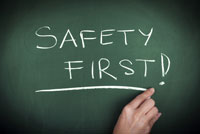Carbon Monoxide Dangers are Real — Ways to Keep Safe
Carbon monoxide (CO) is a toxic gas that can severely injure, or even kill you because it’s impossible to smell, taste or see. Even relatively low levels of exposure can make you sick over time. It can cause flu-like symptoms, including dizziness, headaches, fatigue, confusion and nausea.
To avoid the dangers of carbon monoxide poisoning, it’s vital that combustion equipment such as your furnace, water heater or gas stove is always properly maintained and operated. Also avoid idling your car or running gas-powered tools in an attached garage. Both your house and garage should have proper ventilation. Additionally, generators should never be used indoors. These can create deadly levels of CO build-up that can linger for hours after the generator has turned off.
Other ways to avoid carbon monoxide dangers and keep levels within safe limits include:
- Ensure gas appliances are properly installed and maintained.
- Consider replacing an unvented space heater with a vented one.
- Your gas stove should have an exhaust fan that’s vented to the outside.
- Use the correct fuel in kerosene space heaters.
- Open fireplace flues when in use.
- Never let any vehicles idle inside an enclosed space.
- Choose properly sized EPA-certified wood stoves. Additionally, take care to ensure the doors on all wood stoves fit snugly.
- A trained professional should annually inspect, clean and maintain your whole forced-air heating system, from the furnace to the ducts.
Carbon Monoxide Sources
Some sources of CO gas include gas space heaters and water heaters; unvented kerosene heaters; leaking chimneys and furnaces; wood and gas stoves, fireplaces and furnaces back-drafting; generators and other gasoline-powered equipment, including automobile exhaust; and tobacco smoke.
Carbon Monoxide Detection
Make sure you home is equipped with at least one CO detector, but preferably one on each floor of hour home, including near the main sleeping area. If you have an attached garage, install a detector near the adjoining door. Once your CO detectors are installed, test them regularly, and make sure battery-operated models have fresh batteries.
We’ve served Martin, Palm Beach and Indian River counties since 1973. To learn more about preventing carbon monoxide dangers in your home, please contact us at NisAir Air Conditioning and Heating.

